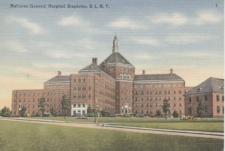Willowbrook State School
| Willowbrook State School | |
|---|---|
 | |
| Construction Began | 1938 |
| Opened | 1947 |
| Closed | 1987 |
| Current Status | Closed |
| Building Style | Cottage Plan |
| Architect(s) | William E. Hauugaard |
| Location | Staten Island, NYC, NY |
| Architecture Style | Colonial Revival |
| Peak Patient Population | 6,200 in 1969 |
| Alternate Names |
|
History[edit]
In 1938, plans were formulated to build a facility for mentally retarded children on a 375 acres (1.5 km²) site in the Willowbrook section of the Staten Island. Construction was completed in 1942, but instead of opening for its original purpose, it was converted into a United States Army hospital and named Halloran General Hospital, after the late Colonel Paul Stacey Halloran. After the war, proposals were introduced to turn the site over to the Veterans Administration, but in October, 1947 the New York State Department of Mental Hygiene opened its facility there as originally planned, and the institution was named Willowbrook State School.
Throughout the first decade of its operation, outbreaks of hepatitis were common at the school. This led to a highly controversial medical study being conducted there between 1963 and 1966, in which healthy children were intentionally injected with the virus that causes the disease. These studies were designed to gain an understanding of the natural history of infectious hepatitis and subsequently to test the effects of gamma globulin in preventing or combating the disease.
The subjects, all children, were deliberately infected with the hepatitis virus; early subjects were fed extracts of stools from infected individuals and later subjects received injections of more purified virus preparations. Investigators defended the deliberate injection of these children by pointing out that the vast majority of them acquired the infection anyway while at Willowbrook, and perhaps it would be better for them to be infected under carefully controlled research conditions.
During the course of these studies, Willowbrook closed its doors to new patients, claiming overcrowded conditions. However, the hepatitis program, because it occupied its own space at the institution, was able to continue to admit new patients. Thus, in some cases, parents found that they were unable to admit their child to Willowbrook unless they agreed to his or her participation in the studies. This case caused a public outcry forcing the study to be discontinued because of the perception that parents and their children were given little choice about whether or not to participate in research. In 1965, Senator Robert Kennedy paid an unannounced visit to Willowbrook. He found thousands of residents “living in filth and dirt, their clothing in rags, in rooms less comfortable and cheerful than the cages in which we put animals in a zoo.” Kennedy went on to describe the institution as a “snake pit.” The visit put conditions at Willowbrook into the national spotlight and the state of New York responded by developing a five-year improvement plan. However, after making minor adjustments, conditions at the institution quickly reverted to the inhumane conditions that had thrust it into public consciousness.
Through the several decades that Willowbrook was opened, there were continuous allegations of abuse reported on by the local paper, The Staten Island Advance. For many years, these allegations were dismissed and Willowbrook continued to uphold its well-respected reputation in the community. However by early 1972, Geraldo Rivera, then a reporter for television station WABC in New York, conducted a series of investigations at Willowbrook (on the heels of a previous series of articles in the Staten Island Advance and Staten Island Register newspapers), uncovering a host of deplorable conditions, including overcrowding, inadequate sanitary facilities, and physical abuse of residents by members of the school's staff. This resulted in a class-action lawsuit being filed against the State of New York in federal court on March 17, 1972. A settlement in the case was reached on May 5, 1975, mandating reforms at the site, but several years would elapse before all of the violations were corrected. The publicity generated by the case was a major contributing factor to the passage of a federal law, called the Civil Rights of Institutionalized Persons Act of 1980.
In 1983, the State of New York announced plans to close Willowbrook, which had been renamed the Staten Island Developmental Center in 1974. By the end of March 1986, the number of residents housed there had dwindled to 250 (down from 5,000 at the height of the scandal exposed by Rivera), and the last children left the grounds on September 17, 1987. After the developmental center closed, the site became the focus of intense local debate about what should be done with the property. In 1989 a portion of the land was acquired by the City of New York, with the intent of using it to establish a new campus for the College of Staten Island. The new campus opened at Willowbrook in 1993 (at the same time, one of CSI's two other existing campuses, located in the island's Sunnyside neighborhood, was closed and that site became the home of a new high school). At 204 acres, this campus is the largest maintained by the City University of New York.
The remaining 171 acres of the state school's original property, at the south end, is still under the administration of the New York State Department of Mental Hygiene, which maintains a facility there called the Institute For Basic Research in Developmental Disabilities. At the Institution research is conducted on Down Syndrome, Autism, Alzheimer’s Disease and many rare diseases.
- From 1956 to 1971 residents at Willowbrook were infected with live hepatitis to develop a vaccine. Some parents gave consent only because it would allow their child acceptance into the overcrowded facility.
- It has been speculated that this school was was one of the schools shown in the expose book Christmas in Purgatory by Burton Blatt and Fred Kaplan. Burton Blatt never publicly announced what the other four schools in the book were. He said that he would rather the pictures in the book be looked as current conditions in every state school instead of a select few in the North East.
Images[edit]
Main Image Gallery: Willowbrook State School
Video[edit]
- A twenty-seven minute expose on Willowbrook State School, by Geraldo Rivera, was entitled "Willowbrook: the Last Great Disgrace."
- In 1997, the documentary entitled: Unforgotten: 25 Years After Willowbrook. It recounts what happened inside the state school, the impact of Rivera's expose, and life afterword. Along with that, the documentary follows four people and their families both before, during, and after the closure of the institution. (In March, 2009, a fire in a residence in upstate Wells, New York, killed four members of the "Willowbrook Class" that was featured in this film.)


